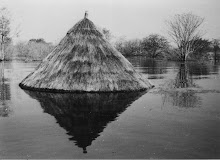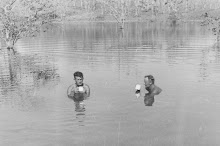Once again, I must apologise for not better keeping this blog updated. Life is, as usual, hectic, and sadly Operation Noah has had to take a backseat to more pressing priorities in the past few weeks.
I have recently received a great number of comments which indicate the level of interest in the story of Operation Noah is far higher than I had anticipated! Some are from nature lovers and conservationists, some are ex- or current Zimbabweans, and others are from people who knew and worked with my grandfather. I never imagined just how many people I would be connected with, from all over the world, by starting this blog. Testament to the power of the Internet!
Many of you mention you knew the Fothergills (my mum's family) when they were in Zimbabwe (or Rhodesia as it was at the time). If you would like to get in touch with Martin (currently in New Zealand) or Hilary or Christine (both in Australia), please leave your email address or other contact details in the comments section and I'll pass on to them.
If anyone has memories of my grandfather or the rescue operation that they would like to share, I would be delighted to publish them here on the site. Again, just leave your email address for me in the comments section and I will be in touch.
A few people have also expressed an interest in obtaining a copy of the Operation Noah footage on DVD - this is certainly something we're working towards, and I will keep you posted on how we progress towards figuring out how to fund and distribute copies. We've also got a bit of a dream of producing a documentary in the works... it would be great to be able to go back to Kariba and see how the wildlife is faring today. Obviously how the situation in Zimbabwe pans out over the next few years will determine whether or not that is feasible.
Many thanks again to everyone for your interest and support!
Tuesday, June 16, 2009
Photo of the Month - A Little Light Relief

May, 1959: Rupert Fothergill has a little light relief from the serious and strenuous work of game rescue. Here he is seen picking up a leguaan (a species of reptile that looks similar to a small crocodile) out of the water from a small boat. These reptiles are not in any danger, as this is a member of the family of leguaan which live in the water.
Wednesday, April 29, 2009
Photo Of The Month - Waiting in the Water
 May 1959: Rupert Fothergill
May 1959: Rupert FothergillThursday, March 26, 2009
Photo Of The Month - Waterbuck Doe
Wednesday, March 25, 2009
An AWOL Update
Hello to all! This is just a brief post to let you know that I haven't fallen off the face of the planet, and will be back soon to continue working on this blog and telling the story of Operation Noah.
I was off travelling through South America from May through to December last year and my life has been somewhat hectic since my return. Things will settle down in a few weeks, and then I'll have more time to dedicate to this blog.
In the mean time, I'll treat you animal lovers to some videos of an orphaned oso melero (tamandua) that I was fortunate enough to nurse while doing some conservation work of my own at El Puma Ecological Park in Posadas, Argentina. She was brought in to the clinic at 3 days old - umbilical cord still attached! - after her mother was shot by farmers. My Spanish was so rubbish at this point that I didn't really understand what I was agreeing to when I nodded and said "Sí, sí" and suddenly I found myself landed with 24-hour care of her. Oso melero literally translates to "honey bear", so naturally I named her Winnie.

Sadly, after almost three weeks of three-hourly syringe feeds (even throughout the night) of a mixture of crushed dog biscuits, banana, honey, powdered milk, baby formula and warm water, and despite having gained weight and showing a number of signs of improvement, Winnie died. Apparently this species is notoriously difficult to keep alive in captivity - even as fully grown adults. The nutrition requirements of their natural diet of honey and termites is extremely difficult to replicate. I was told right from the outset that she had only had extremely slim chances of survival, having likely missed out on too much of her mother's colostrum milk, but was nonetheless devastated when she didn't make it.
Pre-feed, searching for "las mamas" (breasts):
With her snout in the trough:
...and now exhausted from all that hoovering, she curls up into a ball for a nap:
And taking her first wobbly steps:
I was off travelling through South America from May through to December last year and my life has been somewhat hectic since my return. Things will settle down in a few weeks, and then I'll have more time to dedicate to this blog.
In the mean time, I'll treat you animal lovers to some videos of an orphaned oso melero (tamandua) that I was fortunate enough to nurse while doing some conservation work of my own at El Puma Ecological Park in Posadas, Argentina. She was brought in to the clinic at 3 days old - umbilical cord still attached! - after her mother was shot by farmers. My Spanish was so rubbish at this point that I didn't really understand what I was agreeing to when I nodded and said "Sí, sí" and suddenly I found myself landed with 24-hour care of her. Oso melero literally translates to "honey bear", so naturally I named her Winnie.

Sadly, after almost three weeks of three-hourly syringe feeds (even throughout the night) of a mixture of crushed dog biscuits, banana, honey, powdered milk, baby formula and warm water, and despite having gained weight and showing a number of signs of improvement, Winnie died. Apparently this species is notoriously difficult to keep alive in captivity - even as fully grown adults. The nutrition requirements of their natural diet of honey and termites is extremely difficult to replicate. I was told right from the outset that she had only had extremely slim chances of survival, having likely missed out on too much of her mother's colostrum milk, but was nonetheless devastated when she didn't make it.
Pre-feed, searching for "las mamas" (breasts):
With her snout in the trough:
...and now exhausted from all that hoovering, she curls up into a ball for a nap:
And taking her first wobbly steps:
Subscribe to:
Posts (Atom)





